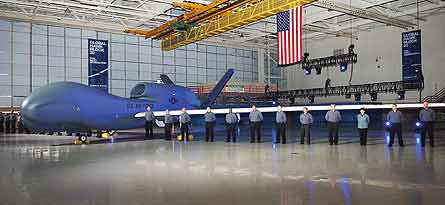Tests to start on upgraded and modified UAV as Northrop Grumman prepares to present smaller vehicle to US Navy
Northrop Grumman is preparing to undertake the first taxi tests with the larger and upgraded RQ-4 Block 20 Global Hawk unmanned air vehicle, following the aircraft's official unveiling on 25 August at the US Air Force's Plant 42 in Palmdale, California.
The taxi tests, which are due to begin later this month before a first flight in around mid-November, mark the start of a busy period for Northrop's Global Hawk team. The company will also this month hand over the US Navy's second Block 10 Global Hawk maritime demonstration vehicle at NAS Patuxent River, Maryland, and will in October deliver an operational Block 10 aircraft to Beale AFB, California.
Operational assessment work is meanwhile under way at Edwards AFB, California on the Global Hawk's full-up production-standard ground segment software. "This will be used to help stand up operations at Beale, and to support deployments," says Northrop Grumman Integrated Systems USAF Global Hawk programme office director George Guerra.
|
|
|---|
The Global Hawk Block 20 was unveiled at the US Air Force's Plant 42 in Palmdale, California last month |
"Two Block 10s are currently deployed and the other five are at Edwards in various stages of test and assembly," says Guerra, who adds that "all will eventually go to Beale". The first Block 20 aircraft is the 17th Global Hawk to be built, and will be followed by a further five examples.
Initial assembly work is also now under way on vehicle AF13, the first Block 30 variant, which will carry an Advanced Signals Intelligence Payload (ASIP) for high and low-band electronic signals collection. Test and validation of the Block 30 with ASIP sensors is expected to take place in 2007-8, adds Guerra.
In addition to the six Block 20s already ordered for the USAF, Northrop plans to supply 26 Block 30s and up to 15 Block 40s, with the latter to carry the Multi-Platform Radar Technology Insertion Programme (MP-RTIP) air-to-air/air-to-surface radar under development with Raytheon. This is expected to be flown for the first time around 29 September on the Scaled Composites-built Proteus test aircraft.
Source: Flight International
























